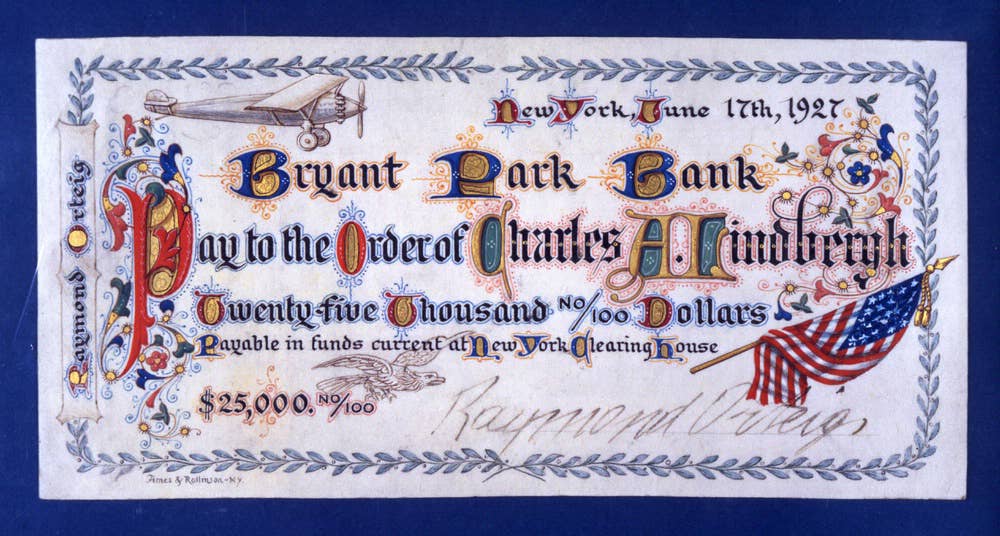
A copy of the check awarding a cool $25,000 to Charles Lindbergh from Raymond Orteig after the pilot’s famous crossing. Smithsonian National Air and Space Museum
On June 20, Wally Funk launched into space, fulfilling a quest she had pursued for her entire life.
But the main buzz wasn’t about Wally’s achievement, but the means by which she got there at last—as a guest of one of the world’s wealthiest people, Jeff Bezos, aboard the Blue Origin rocket, in New Shepard.
It didn’t help that the race to the edge of space in recent times has appeared to be the playground of rich folks such as Bezos and Richard Branson, who egged on his most visible competitor in a contest for who was first, and a disagreement about what “space” means.
This is nothing new to the space race—nor to aviation records in general.
Take crossing the Atlantic—or flying around the world.
Long, Storied History
Charles Lindbergh famously secured the Orteig Prize in 1927 by flying from New York to Paris in the Spirit of St. Louis, a Ryan NYP modified for the journey.
The launch of the Douglas DC-1 and DC-2, in 1933 and 1934 respectively, came at a time when the U.S. had slipped behind in setting international aviation records. It had been eight years since Lindbergh’s historic Atlantic crossing when Transcontinental & Western Air loaned its sole DC-1 to the National Aeronautic Association (NAA) for the express purpose of chasing records—and proving the capability of the commercially viable twin to cross oceans.
On May 16, 1935, loaded with extra weight to meet international class criteria, the DC-1 took off from Floyd Bennett Field on Long Island, New York, and climbed to 10,000 feet, heading south. For more than 18 hours, the DC-1 stayed aloft, pacing a triangular course between New York, Washington, D.C., and Norfolk—and it broke a record roughly every three hours. At 1:50 a.m. on the 17th, the DC-1 ticked over 5,000 km—just short of Lindbergh’s 3,600-mile flight—with a transport-category airplane that could carry a dozen people.
While droning around a course over the eastern U.S. may have seemed like folly to those below—many of whom could not feature getting into such a contraption—an important milestone was reached in the minds of those who could look into the future.
One of the most influential people in aviation history that you may not have heard about was a wealthy Wichita businessman named Jacob “Jake” Moellendick. He provided the venture capital that launched the E.M. Laird Company—and brought together E.M. Laird, Lloyd Stearman, and Walter Beech for their first enterprise.
Actress Ruth Elder would pilot the Laird Swallow in the 1929 Women’s Air Derby—covering roughly 2,500 miles in nine days. The draw of the unusual—and a film star—turned heads then, and it still does today.
The Thrilling, Question-Filled Present
The XPrize Foundation—an Orteig Prize for the modern day—launched in 1996 with the help of Lindbergh’s grandson, Erik. The original Ansari X Prize offered $10 million to an entity—outside of a governmental one—that launched a reusable, crewed spacecraft into space twice within two weeks. Scaled Composites’ Tier One secured the prize—and now the foundation offers increasing awards for achievement in various verticals that play into space exploration. It prides itself on making those competitions accessible to “regular folks.”
Whether it will achieve that parallel goal remains to be seen. Our gaze has typically been attracted by those “celebrities” in our midst: the rich, the connected, the attractive, the glamorous—and the unusual. In their best expression, they draw attention to the cause underlying the act.
I was running on a treadmill at the YMCA in Boulder, Colorado, in 1996 when on the television I saw the news break of the Cessna Cardinal accident in Cheyenne, Wyoming, that killed 7-year-old Jessica Dubroff. I was working as an instructor—we sent students up on a regular basis to Cheyenne to knock out solo cross-country flights since it was just the right distance. The footage was viscerally painful to watch.
There’s a difference between honest achievement by a young adult and pulling a stunt with a child’s face on it.
And that’s why for me the current around-the-world bid by 19-year-old Zara Rutherford stands apart from a stunt and crosses firmly into the category of achievement that can move the needle for us all.
The flight—sponsored by a host of corporations and individuals—demonstrates the capability of both the pilot and the unique airplane she’s flying. The Shark Aero is in the microlight category under EASA, and showcasing the advancements made help propel forward her goal of promoting flying and opportunities for young women in STEM fields. She’s qualified as a pilot—and just passed her A-levels in mathematics, further mathematics, economics, and physics.
Lindbergh was 25 when he crossed the Atlantic. Funk was 22 when she entered the Mercury 13 program—and 82 when she launched into space.
Marking these milestones with them inspires us, and compels us to our own greater achievements.

Sign-up for newsletters & special offers!
Get the latest FLYING stories & special offers delivered directly to your inbox






